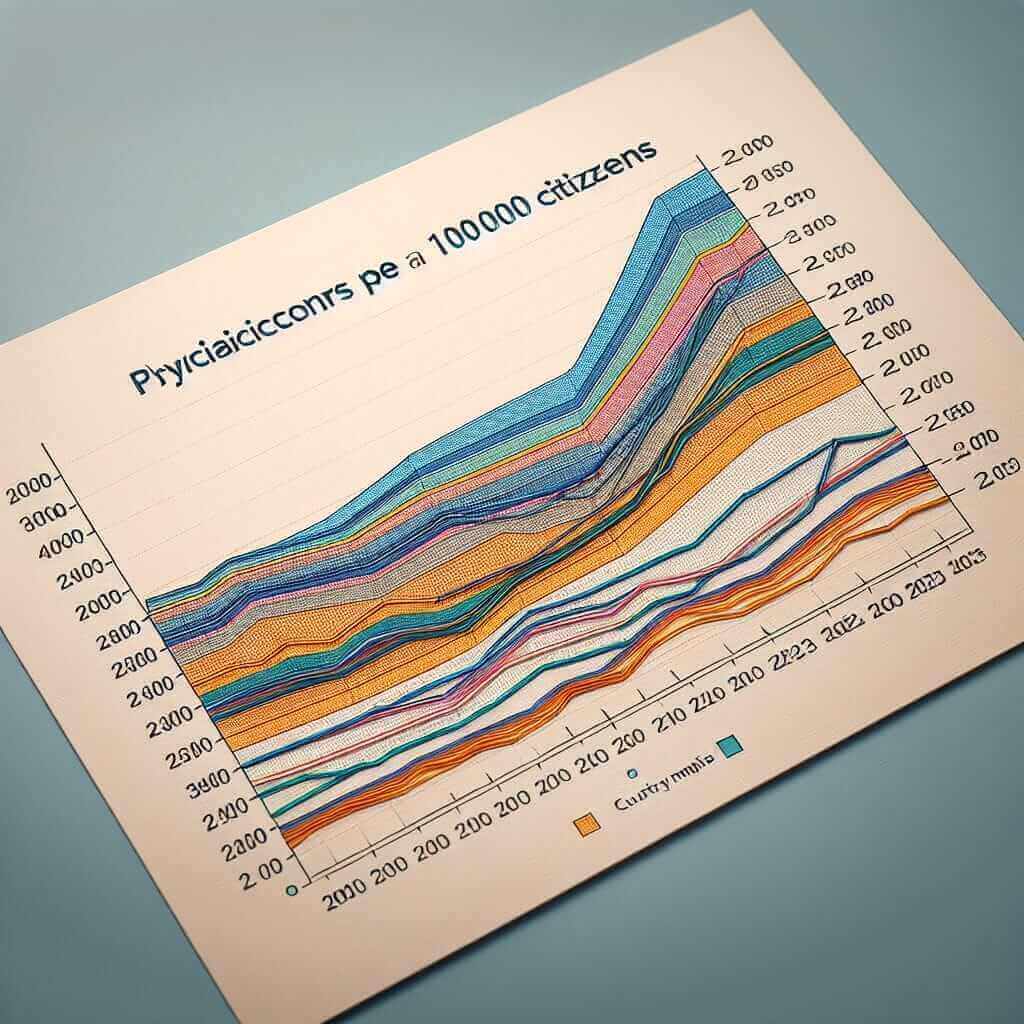In the IELTS Writing Task 1, you might encounter various types of data representation such as bar charts, pie charts, line graphs, and tables. One common topic you might come across is data on the number of doctors per 1000 people in different countries over a period. This type of data requires you to describe, compare, and analyze trends effectively. In this lecture, I’ll guide you through understanding and tackling such a topic in detail.
Introduction to the Topic
The number of doctors per 1000 people is a critical metric for assessing the healthcare quality and accessibility in different countries. Data from the years 2000 to 2023 can illustrate trends and disparities in healthcare provisions across various regions. For instance, developed countries might show a stable or increasing number of doctors, whereas developing countries may struggle with lower ratios.
Possible Task Prompts
Here are some example prompts related to this topic:
- “The table below shows the number of doctors per 1000 people in five different countries between 2000 and 2023. Summarize the information by selecting and reporting the main features, and make comparisons where relevant.”
- “The chart illustrates the number of doctors per 1000 people in selected countries from 2000 to 2023. Summarize the information and describe the main trends.”
- “The line graph provides information about the number of doctors per 1000 people in various countries over a period from 2000 to 2023. Summarize the data and highlight significant trends and comparisons.”
Example Task and Data Representation
Let’s choose the first example:
Task Prompt
“The table below shows the number of doctors per 1000 people in five different countries between 2000 and 2023. Summarize the information by selecting and reporting the main features, and make comparisons where relevant.”
Data Table
| Year | Country A | Country B | Country C | Country D | Country E |
|------|-----------|-----------|-----------|-----------|-----------|
| 2000 | 2.5 | 1.2 | 3.0 | 0.8 | 1.5 |
| 2005 | 2.7 | 1.4 | 3.1 | 0.9 | 1.7 |
| 2010 | 2.9 | 1.6 | 3.2 | 1.0 | 1.8 |
| 2015 | 3.0 | 1.8 | 3.3 | 1.1 | 2.0 |
| 2020 | 3.2 | 2.0 | 3.4 | 1.2 | 2.2 |
| 2023 | 3.4 | 2.2 | 3.5 | 1.3 | 2.4 |
Analyzing the Task
Key Points for Analysis
- Identify Trends: Look at overall trends in the data. For instance, which countries have increased their doctors-per-1000-people ratio over the years? Are there any countries with significant growth?
- Compare Countries: Compare the figures from different countries. Which country had the highest ratio in 2000? How did it change by 2023?
- Highlight Features: Emphasize key features in the data. For instance, which country had the most significant increase, or which had the most stable numbers?
Sample Writing
Introduction
The table illustrates the number of doctors per 1000 people in five different countries over a period from 2000 to 2023. Overall, the data reveal an increasing trend in the number of doctors per capita in all countries surveyed.
Summary of Main Features
From 2000 to 2023, Country A consistently had the highest ratio of doctors per 1000 people, starting at 2.5 and gradually increasing to 3.4. In contrast, Country D had the lowest ratios throughout the years, though its numbers did improve from 0.8 in 2000 to 1.3 in 2023.
Detailed Comparisons and Trends
Further analysis shows that Country B exhibited a steady increase, doubling its ratio from 1.2 in 2000 to 2.2 in 2023. Country C remained relatively stable with the highest starting point at 3.0 and the end at 3.5. Meanwhile, Country E saw a gradual yet less pronounced growth from 1.5 to 2.4 over the same period.
Conclusion
In summary, while all countries showed improvements in the number of doctors per 1000 people, there remains a clear disparity in healthcare provisions, as indicated by the varying rates of increase among different countries. This trend highlights ongoing challenges and progress in global healthcare accessibility.
(Word count: 207)
Tips and Vocabulary
Grammar and Vocabulary Tips
- Comparative Structures: Use phrases like “more than,” “less than,” “as…as,” and superlatives like “the highest,” “the lowest.”
- Trend Language: Use verbs like “increase,” “rise,” “grow,” “decrease,” “fall,” and adjectives like “steady,” “rapid,” “significant.”
Key Vocabulary
- Ratio (n) /ˈreɪʃiəʊ/: The quantitative relation between two amounts.
- Per Capita (adj) /pɜːr ˈkæpɪtə/: Per person.
- Disparity (n) /dɪˈspærɪti/: A great difference.
- Consistently (adv) /kənˈsɪstəntli/: In every case or on every occasion; invariably.
- Pronounced (adj) /prəˈnaʊnst/: Very noticeable or marked.
Conclusion
Mastering the IELTS Writing Task 1 requires a solid understanding of data representation, trend analysis, and effective linguistic skills. By practicing with real-world data like the number of doctors per 1000 people, you can develop the ability to describe complex information clearly and concisely – a valuable skill for achieving a high band score. Remember to focus on clarity, accuracy, and appropriate vocabulary usage to enhance your writing.